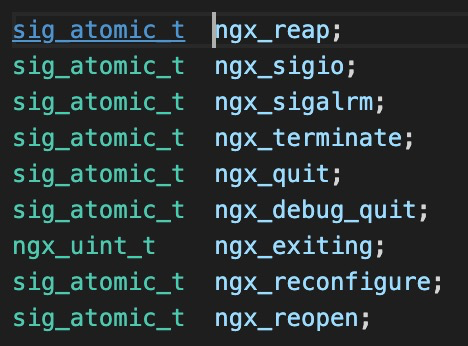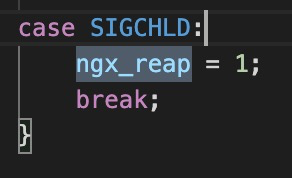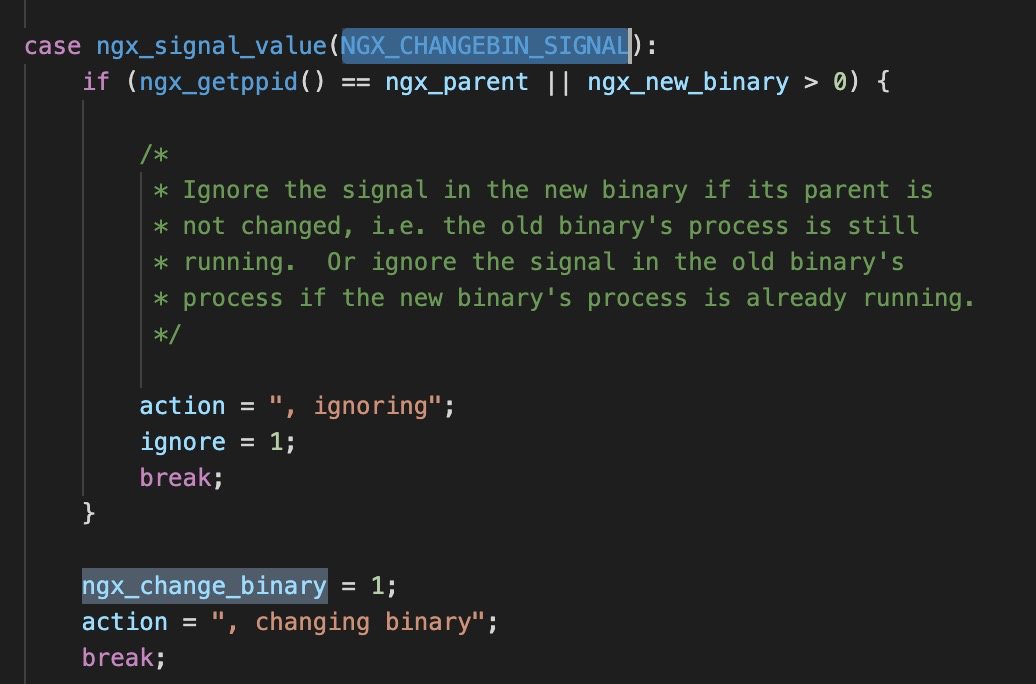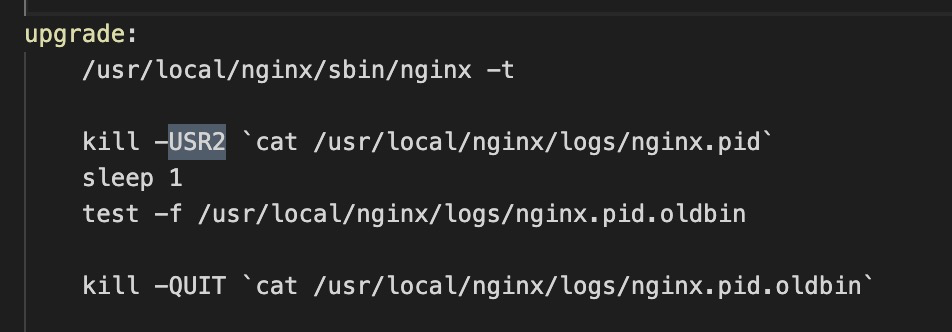1, Explain
2, Function analysis
ngx_new_binary = 0;
delay = 0;
sigio = 0;
live = 1;
for ( ;; ) {
if (delay) {
if (ngx_sigalrm) {
sigio = 0;
delay *= 2;
ngx_sigalrm = 0;
}
ngx_log_debug1(NGX_LOG_DEBUG_EVENT, cycle->log, 0,
"termination cycle: %M", delay);
itv.it_interval.tv_sec = 0;
itv.it_interval.tv_usec = 0;
itv.it_value.tv_sec = delay / 1000;
itv.it_value.tv_usec = (delay % 1000 ) * 1000;
if (setitimer(ITIMER_REAL, &itv, NULL) == -1) {
ngx_log_error(NGX_LOG_ALERT, cycle->log, ngx_errno,
"setitimer() failed");
}
}
ngx_log_debug0(NGX_LOG_DEBUG_EVENT, cycle->log, 0, "sigsuspend");
sigsuspend(&set);
ngx_time_update();
ngx_log_debug1(NGX_LOG_DEBUG_EVENT, cycle->log, 0,
"wake up, sigio %i", sigio);
if (ngx_reap) {
ngx_reap = 0;
ngx_log_debug0(NGX_LOG_DEBUG_EVENT, cycle->log, 0, "reap children");
live = ngx_reap_children(cycle);
}
if (!live && (ngx_terminate || ngx_quit)) {
ngx_master_process_exit(cycle);
}
if (ngx_terminate) {
if (delay == 0) {
delay = 50;
}
if (sigio) {
sigio--;
continue;
}
sigio = ccf->worker_processes + 2 /* cache processes */;
if (delay > 1000) {
ngx_signal_worker_processes(cycle, SIGKILL);
} else {
ngx_signal_worker_processes(cycle,
ngx_signal_value(NGX_TERMINATE_SIGNAL));
}
continue;
}
if (ngx_quit) {
ngx_signal_worker_processes(cycle,
ngx_signal_value(NGX_SHUTDOWN_SIGNAL));
ngx_close_listening_sockets(cycle);
continue;
}
if (ngx_reconfigure) {
ngx_reconfigure = 0;
if (ngx_new_binary) {
ngx_start_worker_processes(cycle, ccf->worker_processes,
NGX_PROCESS_RESPAWN);
ngx_start_cache_manager_processes(cycle, 0);
ngx_noaccepting = 0;
continue;
}
ngx_log_error(NGX_LOG_NOTICE, cycle->log, 0, "reconfiguring");
cycle = ngx_init_cycle(cycle);
if (cycle == NULL) {
cycle = (ngx_cycle_t *) ngx_cycle;
continue;
}
ngx_cycle = cycle;
ccf = (ngx_core_conf_t *) ngx_get_conf(cycle->conf_ctx,
ngx_core_module);
ngx_start_worker_processes(cycle, ccf->worker_processes,
NGX_PROCESS_JUST_RESPAWN);
ngx_start_cache_manager_processes(cycle, 1);
/* allow new processes to start */
ngx_msleep(100);
live = 1;
ngx_signal_worker_processes(cycle,
ngx_signal_value(NGX_SHUTDOWN_SIGNAL));
}
if (ngx_restart) {
ngx_restart = 0;
ngx_start_worker_processes(cycle, ccf->worker_processes,
NGX_PROCESS_RESPAWN);
ngx_start_cache_manager_processes(cycle, 0);
live = 1;
}
if (ngx_reopen) {
ngx_reopen = 0;
ngx_log_error(NGX_LOG_NOTICE, cycle->log, 0, "reopening logs");
ngx_reopen_files(cycle, ccf->user);
ngx_signal_worker_processes(cycle,
ngx_signal_value(NGX_REOPEN_SIGNAL));
}
if (ngx_change_binary) {
ngx_change_binary = 0;
ngx_log_error(NGX_LOG_NOTICE, cycle->log, 0, "changing binary");
ngx_new_binary = ngx_exec_new_binary(cycle, ngx_argv);
}
if (ngx_noaccept) {
ngx_noaccept = 0;
ngx_noaccepting = 1;
ngx_signal_worker_processes(cycle,
ngx_signal_value(NGX_SHUTDOWN_SIGNAL));
}
}
The old rule is to analyze it paragraph by paragraph, but the code looks easy to understand.
if (delay) {
if (ngx_sigalrm) {
sigio = 0;
delay *= 2;
ngx_sigalrm = 0;
}
ngx_log_debug1(NGX_LOG_DEBUG_EVENT, cycle->log, 0,
"termination cycle: %M", delay);
itv.it_interval.tv_sec = 0;
itv.it_interval.tv_usec = 0;
itv.it_value.tv_sec = delay / 1000;
itv.it_value.tv_usec = (delay % 1000 ) * 1000;
if (setitimer(ITIMER_REAL, &itv, NULL) == -1) {
ngx_log_error(NGX_LOG_ALERT, cycle->log, ngx_errno,
"setitimer() failed");
}
}sigsuspend(&set);

ngx_time_update();
When the master process processes information, it updates the cache time.
if (ngx_reap) {
ngx_reap = 0;
ngx_log_debug0(NGX_LOG_DEBUG_EVENT, cycle->log, 0, "reap children");
live = ngx_reap_children(cycle);
}
ngx_ reap_ The children function traverses ngx_process array, check the status of each child process, and restart the process that exited abnormally. Only when all child processes exit normally, live will be 0, and the returned live at other times will be 1. This means that if it is an abnormal exit, the process will be pulled up again. If an exit command is received, it will exit normally.
if (!live && (ngx_terminate || ngx_quit)) {
ngx_master_process_exit(cycle);
}

if (ngx_terminate) {
if (delay == 0) {
delay = 50;
}
if (sigio) {
sigio--;
continue;
}
sigio = ccf->worker_processes + 2 /* cache processes */;
if (delay > 1000) {
ngx_signal_worker_processes(cycle, SIGKILL);
} else {
ngx_signal_worker_processes(cycle,
ngx_signal_value(NGX_TERMINATE_SIGNAL));
}
continue;
}When terminating, it was mentioned earlier to set the delay timeout. If there is no timeout, it will be executed

if (ngx_quit) {
ngx_signal_worker_processes(cycle,
ngx_signal_value(NGX_SHUTDOWN_SIGNAL));
ngx_close_listening_sockets(cycle);
continue;
}if (ngx_reconfigure) {
ngx_reconfigure = 0;
if (ngx_new_binary) {
ngx_start_worker_processes(cycle, ccf->worker_processes,
NGX_PROCESS_RESPAWN);
ngx_start_cache_manager_processes(cycle, 0);
ngx_noaccepting = 0;
continue;
}
ngx_log_error(NGX_LOG_NOTICE, cycle->log, 0, "reconfiguring");
cycle = ngx_init_cycle(cycle);
if (cycle == NULL) {
cycle = (ngx_cycle_t *) ngx_cycle;
continue;
}
ngx_cycle = cycle;
ccf = (ngx_core_conf_t *) ngx_get_conf(cycle->conf_ctx,
ngx_core_module);
ngx_start_worker_processes(cycle, ccf->worker_processes,
NGX_PROCESS_JUST_RESPAWN);
ngx_start_cache_manager_processes(cycle, 1);
/* allow new processes to start */
ngx_msleep(100);
live = 1;
ngx_signal_worker_processes(cycle,
ngx_signal_value(NGX_SHUTDOWN_SIGNAL));
}
if (ngx_change_binary) {
ngx_change_binary = 0;
ngx_log_error(NGX_LOG_NOTICE, cycle->log, 0, "changing binary");
ngx_new_binary = ngx_exec_new_binary(cycle, ngx_argv);
}

if (ngx_restart) {
ngx_restart = 0;
ngx_start_worker_processes(cycle, ccf->worker_processes,
NGX_PROCESS_RESPAWN);
ngx_start_cache_manager_processes(cycle, 0);
live = 1;
}This is simply to restart. There is no corresponding signal, that is, NGX is set in the processing logic_ Restart is processed.
if (ngx_reopen) {
ngx_reopen = 0;
ngx_log_error(NGX_LOG_NOTICE, cycle->log, 0, "reopening logs");
ngx_reopen_files(cycle, ccf->user);
ngx_signal_worker_processes(cycle,
ngx_signal_value(NGX_REOPEN_SIGNAL));
}if (ngx_noaccept) {
ngx_noaccept = 0;
ngx_noaccepting = 1;
ngx_signal_worker_processes(cycle,
ngx_signal_value(NGX_SHUTDOWN_SIGNAL));
}All processes are not receiving requests. Shut down the processes calmly.